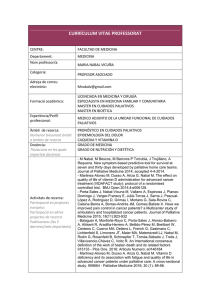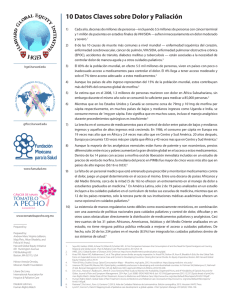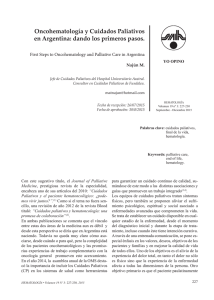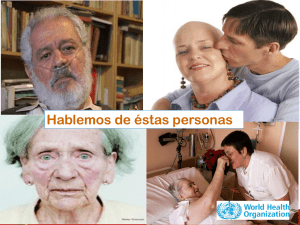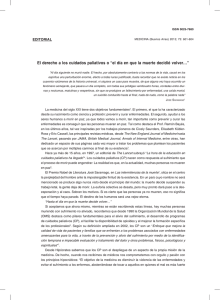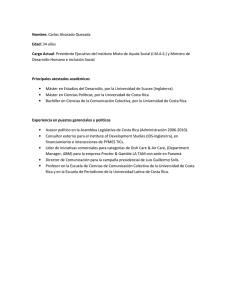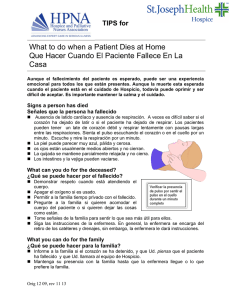BIBLIOGRAFÍA - Junta de Andalucía
Anuncio
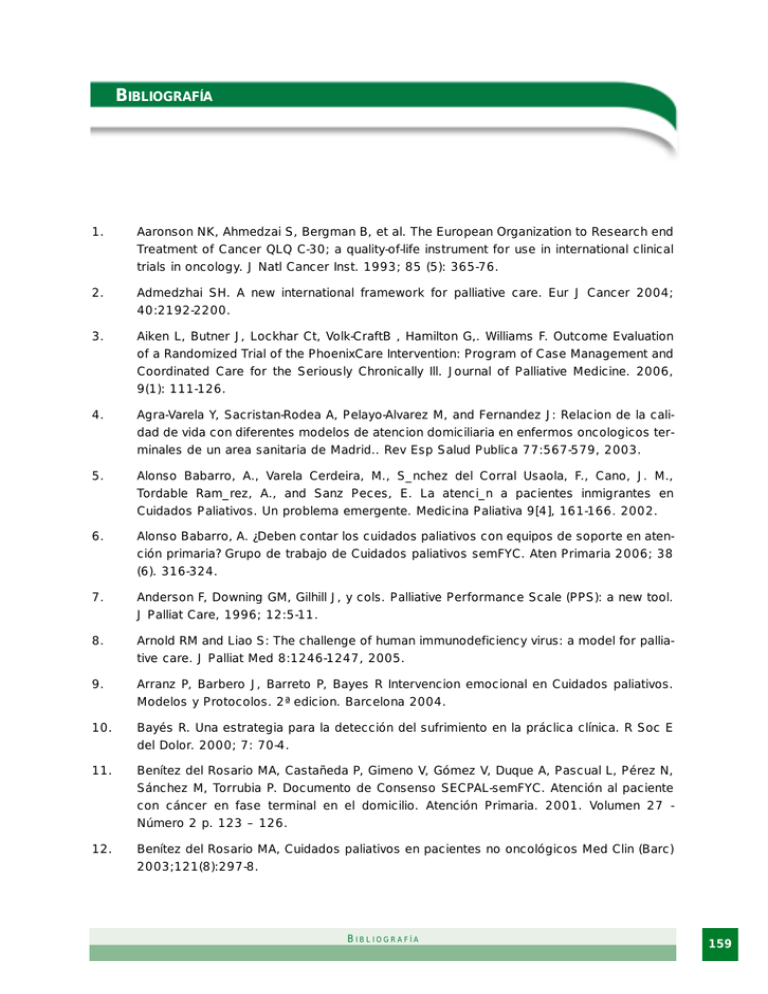
BIBLIOGRAFÍA 1. Aaronson NK, Ahmedzai S, Bergman B, et al. The European Organization to Research end Treatment of Cancer QLQ C-30; a quality-of-life instrument for use in international clinical trials in oncology. J Natl Cancer Inst. 1993; 85 (5): 365-76. 2. Admedzhai SH. A new international framework for palliative care. Eur J Cancer 2004; 40:2192-2200. 3. Aiken L, Butner J, Lockhar Ct, Volk-CraftB , Hamilton G,. Williams F. Outcome Evaluation of a Randomized Trial of the PhoenixCare Intervention: Program of Case Management and Coordinated Care for the Seriously Chronically Ill. Journal of Palliative Medicine. 2006, 9(1): 111-126. 4. Agra-Varela Y, Sacristan-Rodea A, Pelayo-Alvarez M, and Fernandez J: Relacion de la calidad de vida con diferentes modelos de atencion domiciliaria en enfermos oncologicos terminales de un area sanitaria de Madrid.. Rev Esp Salud Publica 77:567-579, 2003. 5. Alonso Babarro, A., Varela Cerdeira, M., S_nchez del Corral Usaola, F., Cano, J. M., Tordable Ram_rez, A., and Sanz Peces, E. La atenci_n a pacientes inmigrantes en Cuidados Paliativos. Un problema emergente. Medicina Paliativa 9[4], 161-166. 2002. 6. Alonso Babarro, A. ¿Deben contar los cuidados paliativos con equipos de soporte en atención primaria? Grupo de trabajo de Cuidados paliativos semFYC. Aten Primaria 2006; 38 (6). 316-324. 7. Anderson F, Downing GM, Gilhill J, y cols. Palliative Performance Scale (PPS): a new tool. J Palliat Care, 1996; 12:5-11. 8. Arnold RM and Liao S: The challenge of human immunodeficiency virus: a model for palliative care. J Palliat Med 8:1246-1247, 2005. 9. Arranz P, Barbero J, Barreto P, Bayes R Intervencion emocional en Cuidados paliativos. Modelos y Protocolos. 2ª edicion. Barcelona 2004. 10. Bayés R. Una estrategia para la detección del sufrimiento en la práclica clínica. R Soc E del Dolor. 2000; 7: 70-4. 11. Benítez del Rosario MA, Castañeda P, Gimeno V, Gómez V, Duque A, Pascual L, Pérez N, Sánchez M, Torrubia P. Documento de Consenso SECPAL-semFYC. Atención al paciente con cáncer en fase terminal en el domicilio. Atención Primaria. 2001. Volumen 27 Número 2 p. 123 – 126. 12. Benítez del Rosario MA, Cuidados paliativos en pacientes no oncológicos Med Clin (Barc) 2003;121(8):297-8. BIBLIOGRAFÍA 159 160 13. Benítez del Rosario M, Pascual L, Fraile A . Cuidados paliativos. La atención a los últimos días. Aten Primaria 2002; 30: 318 – 322. 14. Boceta Osuna J, Cia Ramos R, y cols. Sedación paliativa y sedación terminal. Orientaciones para la toma de decisiones en la Práctica Clínica.Documento de apoyo. Sevilla. Consejeria de salud, 2005. 15. Bruera E, Kuehn N, Miller MJ y cols. The Edmonton Sympton Assessment System (ESAS): a simple method for the assessment of palliative care patients. J Palliat Care, 1991; 7(2): 6-9. 16. Bruera E, Schoeller T, Wenk R, et all. A Prospective multicenter assessment of de Edmonton stading system for cancer pain. J Pain Symtom Manage. 1995; 10 (5): 348-55. 17. Brumley RD, Enguidanos S, and Cherin DA: Effectiveness of a Home-Based Palliative Care Program for End-of-Life. Journal of Palliative Medicine 6:715-724, 2003. 18. Burgess L: Addressing the palliative care needs of people with dementia. Nurs Times 100:36-39, 2004. 19. Byock I, Twohig JS, Merriman M, and Collins K: Promoting excellence in end-of-life care: a report on innovative models of palliative care. J Palliat Med 9:137-151, 2006. 20. Carson MG, Fith MI, Vachon MLS. Measuring patient outcomes in palliative care: a reability and validity study of the Support Ream Assessment Sceduke (STAS), Palliat Med, 2000; 14: 25-6. 21. De Miguel Sanchez C, Lopez Romero, A. El paciente con cáncer avanzado ¿Podemos predecir la supervivencia?- Atención Primaria. Noviembre 2006; 38:2, 2-6. 22. Centeno C, Muñoz JD. Cuidados Paliativos, respuesta bioética de la Medicina a la situación terminal. En: La Bioética; un compromiso existencial y científico. Murcia: Quaderna 2005. 23. Cherin DA, Enguidanos SM, and Jamison P: Physicians as medical center "extenders" in end-of-life care: physician home visits as the lynch pin in creating an end-of-life care system. Home Health Care Serv Q 23:41-53, 2004 24. Chochinov HM, Hack T, Hassard T and cols. Dignity therapy: A novel psychotherapeutic intervention for patients near the end of the life. J Clin Oncol, 2005;23(24):5427-28 (comprobar). 25. Critchley P, Jadad AR, Taniguchi A, Woods A, Stevens R, and Reyno L: Are some palliative care delivery systems more effective and efficient than others: a systematic review of comparative studies. Journal of Palliative Care 15(4):40-47, 1999. 26. Davies E; Higginson I. The Solid Facts. Palliative Care. World Health Organization Europe. Milan 2004. Descripción de la complejidad de los pacientes de la consulta externa de un Servicio de Cuidados paliativos de un Centro Terciario: resultados preliminares. 27. Dierckx DC, Verpoort C, Geutjens D, Van Goubergen W, and Gastmans C: Care for palliative patients on non-palliative units: The role of volunteers. Acta Hospitalia 43:57-73+94, 2003. P R O C E S O C U I D A D O S PA L I AT I V O S 28. Doyle D, Hanks G, Chemy N, Calman K (Eds.). Oxford Textbook of Palliative Medicine. 3rd Edition. Oxford University Press;2004. 29. Duarte M, Boceta J, Cia R, et al. Cuidados Paliativos domiciliarios. Atención integral al paciente y su familia. Documento de apoyo. Sevilla, 2003. Consejería de Salud. 30. Dudgeon DJ, Harlos M, Clinch JJ. The Edmonton Symptom Assessment Scale (ESAS) as an audit tool. J Palliat Care, 1999; 15:14-9Diaz N. Duelo en Bruera E.; y De Lima L. (editores) Cuidados Paliativos: Guías para el manejo Clínico (2ª edición) Organización Panamericana de la Salud. 31. Edwards J: A model of palliative care for the adolescent with cancer. Int J Palliat Nurs 7:485-488, 2001. 32. Emmanuel L, Carla Alexander C, Robert M. Arnold, Richard Bernstein, Richard Dart, Christopher Dellasantina, Lee Dykstra, James Tulsky. Integrating Palliative Care into Disease Management Guidelines. Journal of Palliative Medicine. Dec 2004, Vol. 7, No. 6: 774-783. 33. Escalante CP, Martin CG, Elting LS, Price KJ, Manzullo EF, Weiser MA, Harle TS, Cantor SB, and Rubenstein EB: Identifying risk factors for imminent death in cancer patients with acute dyspnea. Journal of Pain and Symptom Management 20:318-325, 2000. 34. Espinosa E, Gonzalez Baron M, PovedaJ De la Gandara I. La verdad soportable como eje de la información al paciente con càncer. Ann Med Int. 1993; 10: 147-9. 35. Expósito J, Escalera C, Sanchez F,. Planificación de los Cuidados Paliativos basada en proceso. Med Pal 2005, nº extra; 12, 2-4. 36. Fernandez Doblado, S. El paciente con demencia en fase terminal: cuidados mqdicos en domicilio. Geribtrika.Revista Iberolatinoamericana de GeriatrÆa y GerontologÆa 20[2], 106-109. 2004. 37. Ferris F, Gomez-Batiste X, Furst C. Implementing Quality Palliative Care. Journal of Pain and Sympton Management 2007, Vol 33, nº 5: 533. 38. Ferris F, Charles F. von Gunten, Linda L. Emanuel. . Competency in End-of-Life Care: Last Hours of Life Journal of Palliative Medicine. 2003, 6(4): 605-613. 39. Ferris FD and Librach SL: Models, standards, guidelines.. Clin Geriatr Med 21:17-44, 2005. 40. Formiga et al. Morir en el Hospital por enfermedad terminal no oncologica, analisis en la toma de decisiones. Med Clin (Barc)2003; 121 (3): 95-7. 41. Franks P.J.; Salisbury C.; Bosanquet N.; Wilkinson E.K.; Kite S.; Naysmith A.; Higginson I.J. The level of need for palliative care: a systematic review of the literature. Palliative Medicine. Vol. 14, N.2, 1 March 2000, pp. 93-104(12). 42. Francke AL: Evaluative research on palliative support teams: a literature review. Patient Education and Counseling 41(1):83-91, 2000. 43. Friedman J and Bono-Snell B: Palliative care in home care: a model for practice. Caring 23:20-23, 2004. BIBLIOGRAFÍA 161 162 44. Füst Carl, Derek Doyle. The Terminal Phase. En Doyle D, Hanks GW. Oxford Textbook of Medicine Palliative. New York. Oxford University Press, 2004. 45. García Puche; Cabrera J; Camacho T; Cuello JA; Fdez Bautista E; Pérez Ramírez JL; Prados D; Salas MA. Cuidados Paliativos. Proceso Asistencial Integrado. Sevilla, 2002. Consejería de Salud. 46. Garrido Elustondo S, Miguel Sanchez C, Vicente Sanchez F, Cabrera Vélez R, Macé Gutierrez I, Riestra Fernández A. La impresión clínica como estimador del tiempo de supervivencia en pacientes oncológicos en situación terminal. Atención Primaria. Junio 2004. 34:2; 75-80. 47. Goldberg, D., Bridges, K., Duncan-Jones, P. y Grayson, D.A. (1988). Detecting anxiety and depression in general medical settings. British Medical Journal, 97, 897-899. 48. Gomez Sancho M. Atención a la familia. El duelo y el luto, En Medicina Paliativa: la respuesta a una necesidad. Madrid. Aran; 1998 p 481111-542. 49. Gonzalez Baron M, Factores pronósticos en Oncologia Médica. En factores pronósticos en Oncologia. Gonzalez Baron M, Espinosa E, Casado E, Feliu J, De Castro J, Dela Garza J et al. Madrid MacGrawHill; 2005, p1-7. 50. González Barón M. MA Lacasta, Ordoñez A; Valoración clínica en el paciente con cáncer. 2006; Ed. Médica Panamericana, Madrid. 51. Gracia D. Etica en la Práctica Clínica.2004. Ed. Triacastela. Madrid. 52. Guía rápida de manejo avanzado de síntomas en el paciente terminal. J.M Núñez Olarte. Editorial Panamericana. 2007. 53. Hardiman O, Traynor BJ, Corr B, and Frost E: Models of care for motor neuron disease: setting standards. Amyotroph Lateral Scler Other Motor Neuron Disord 3:182-185, 2002. 54. Harding R, Karus D, Easterbrook P, Raveis VH, Higginson IJ, and Marconi K: Does palliative care improve outcomes for patients with HIV/AIDS: a systematic review of the evidence. Sexually Transmitted Infections 81(1):5-14, 2005. 55. Harrold J, Rickerson E, Carroll JT, McGrath J, Morales K, Kapo J, Casarett D. Is the palliative performance scale a useful predictor of mortality in a heterogeneus hospice population? J. Palliat Med.2005 Jun; 8 (3); 503-9. 56. Health care Guideline Palliative Care. ISCI. January 2007. 57. Herrmann C. International experiences with the Hospital Anxiety and Depression Scale--a review of validation data and clinical results. J Psychosom Res. 1997 Jan;42(1):17-41. 58. Herrera Molina E, Rocafort Gil J, Cuervo Pinna MA, Redondo Moralo MJ. Primer nivel asistencial en cuidados paliativos: evolución del contenido de la cartera de servicios de atención primaria y criterios de derivación al nivel de soporte. Aten Primaria 2006; 38[supl 2]: 85-92. 59. Higginson IJ, Mc Carthy M, Validity of the Support Team Schedule: Do Staffs Ratings Reflect Those Made By Patients or their families? Palliative Medicine 1993, 7: 218-19 Mc Carthy M. P R O C E S O C U I D A D O S PA L I AT I V O S 60. Higginson Ij. Clinical and Organitional Audit inPpalliative Medicine. En Oxford Textbook of Palliative Medicine. Doyle D, hanks , Claman K. New York: ; Oxford University Press; 2004; 184-96. 61. Higginson Ij, Constatini M. Accuracy of prognosis estimates by four palliative care teams: A prospective cohort study. BMC Palliat care 2002; 1. 1-5. 62. Holland J, Psychosocial Distress in the patien with cancer: Standars of care and treatment guidelines. Oncology, 2000; 15: 19-24. 63. Homsi J, Walsh D, Rivera N, Rybicki LA, Nelson KA, Legrand SB, et al. Symtom evaluation in palliative medicine: patient report vs systematic assessment. Support Care Cancer ; 14: 444-53. 64. Jaarsma T and Leventhal M: End-of-life issues in cardiac patients and their families. Eur J Cardiovasc Nurs 1:223-225, 2002. 65. Jimenez A, Feliu J, sastre N. Factores implicados en la supervivencia de los pacientes neoplásicos terminales. Propuesta de un nuevo modelo predictivo. Rv. Onc, 2003; 5:31 66. Jimqnez, C. Cuidados paliativos en pacientes con demencia avanzada. Dolor 17[1], 19-26. 2002. 67. Johnson M, Bulechek G, McCloskey J, Maas M, Moorhead S. Diagnósticos enfermeros, Resultados e Intervenciones. Interrelaciones NANDA,NIC,NOC. Ed. Harcourt, 2003. 68. Judith Hills, Judith A. Paice, Jacqueline R. Cameron, Susan Shott. Spirituality and Distress in Palliative Care Consultation Journal of Palliative Medicine. 2005, 8(4): 782-788. 69. Kaasa T, Loomis J, Inoue S, Chihara S. Validity of the Palliative Performance Scale from a survival perspective (PPS) . J Pain Sympton Manage, 1999; 18.2-3). 70. Kaasa T, Loomis J, Gillis K, Bruera E, Hanson J. The Edmonton Functional Assessment Tool (EFAT): preliminary development and evaluation for use in palliative care. J Pain Symptom Manage. 1997 Jan;13(1):10-9. 71. LEY 41/2002, de 14 de noviembre, básica reguladora de la autonomía del paciente y de derechos y obligaciones en materia de información y documentación clínica. BOE nº 274, Madrid.15 de noviembre de 2002, 40126-32. 72. LEY 5/2003, de 9 de octubre, de declaración de voluntad vital anticipada. BOJA nº 210. Sevilla, 31 de octubre, 22.728-30. 73. Lacaste MA, Dario E. El duelo. Guia clinica SECPAL 2004-2005. 74. Lau F, Downing GM, Lesperance M, Shaw J, Kuziemsky C. Use of palliative Performance Scale in end-of-life prognostication. J Palliat Med.2006 =ct; 9 (5): 1066-75. 75. Lorenz, K., Lynn, J., Morton, S. C., Dy, S., Mularski, R., and Shugarman, L. End-of-life care and outcomes. 2004. Rockville: Agency for Healthcare Research and Quality (AHRQ). 76. Lizarraga-Mansoa, S., Ayarra-Elia, M., and Cabodevilla-Eraso, I. Atenci£n a la familia del paciente al final de la vida. FMC.Formaci£n Mqdica Continuada en Atenci£n Primaria 12[10], 692. 2005. BIBLIOGRAFÍA 163 164 77. Maltoni M, Caraceni A, Brunelli C, Broeckaert B, Christakis N, Eychmueller S et al. Prognostic factors in advanced cancer patients:evidence-based clinical recommendationsA study by the Steering Committee of the European Association for Palliative Care. J Clin Oncol 2005 ; 23:6240-8. 78. Mc Carthy M, Higginson IJ, Clinical audit. by a Palliative Care Team (STAS) Palliat Med 1991, 5: 215-221 STAS. 79. McCarthy M, Higginson IJ. Validity of the support team assessment schedule: do staffs' ratings reflect those made by patients or their families? Palliat Med. 1993;7(3):219-28. 80. McNamara B,. Rosenwax L K, CDAJ Holman How to Estimate the Palliative Care Population. Journal of Pain and Symptom Management July 2006, 32:1,5-12 81. Meister L: The VITAS Innovative Hospice Care approach to pediatric palliative care at home. Caring 24:54-61, 2005. 82. Morita T, Tsunoda J, Inone S, Chihara S. The palliative Prognostic Index: a scoring system for survival prediction of terminally ill cancer patients. Support Care Cancer 1999; 7:128-33. 83. Morita T, Hirai K, Sakabuchi Y, et al. Family-Perceive Distress from delirium-relate symtom of terminally ill cancer patient. Psychosomatics. 2004; 45 (2): 107-13. 84. Nabal M, Pascual A, Llombart A. Abordaje integral del paciente oncológico avanzado en atención primaria. Valoración general del paciente oncológico avanzado. Principios de control de síntomas. Aten Primaria. 2006. 38:2;21-28 85. National Institute for Clinical Excellence. Improving supportive and palliative care for adults with cancer. 2004. London: National Institute for Clinical Excellence (NICE). Ref Type: Report. 86. Nekolaichuk et al. A validation study of a pain classification system for advanced cancer patients using content experts: the Edmonton Classification System for Cancer Pain. Palliat Med.2005; 19: 466-476. 87. Nightingale E, Kristjanson LJ, and Toye C: Evaluating the Navigate Care Model: clinical palliative care pathways based on anticipated care outcomes. Int J Palliat Nurs 9:298-307, 2003. 88. Novellas, A. La atencion a las familias en cuidados paliativos. Analisis del Proceso y propuestas metodologicas de intervencion. Medicina Paliativa 7[2], 49-56. 2000. 89. Palomeque Rico, A. Cuidados intensivos y cuidados paliativos. Anales de PediatrÆa 62[5], 409. 2005. 90. Parker RA. Caring for patients at the end of life: Reflections alter 12 years of practice. Ann Intern Med; 2002; 136. 72-6 91. Pirl WF. Evidence report on the ocurrente, assessment and treatment of depression in cancer patients. J Natl Cancer Inst Monogr, 2004; (32): 32-9 92. Plan Integral de Oncología de Andalucía 2002-2006. Sevilla. Consejería de Salud. 2002. P R O C E S O C U I D A D O S PA L I AT I V O S 93. Plan de atención a las cuidadoras familiares de Andalucia.Dirección Regional de Desarrollo e imnovación en cuidados. Sevilla .Servicio Andaluz de Salud.2005 94. Portenoy RK, Forbes K, Lussier D, Hanks G. Difficult pain problems: an integrated approach. En Oxford Text Book of Palliative Medicine, 3ª edicion, Doyle D, Hanks G, Cherny N, Calman K. New York: Oxford University Press 2004. p 438-458 95. Puchalski C, Spiritual Assessment Tool. Journal of Palliative Medicine. 2000, 3(1): 131-131. 96. Quaglietti SE, Atwood JE, Ackerman L, and Froelicher V: Management of the patient with congestive heart failure using outpatient, home and palliative care. Progress in Cardiovascular Diseases 43:259-274, 2000. 97. Robinson, JA, Crawford GB. Identifying palliative care patients with symptoms of depression: an algorithm. Pall Med. 2005; 19:278-87. 98. Rodríguez Vega B, Fernández liria A. Intervenciones sobre problemas relacionados con el duelo para profesionales de Atención Primaria (II):intervenciones desde Atención Primaria de salud. MEDIFAM, 2002; 12: 276-284 99. RubÆ Ponseti, M., Bertrbn de Lis Mas, I., Renom Sotorra, F., GarcÆa de Ancos, J., and Benito Oliver, E. Cuidados Paliativos en las enfermedades respiratorias cr£nicas en fase avanzada. Situaci£n actual y propuesta de organizaci£n asistencial. Medicina Paliativa 12[1], 39-46. 2005. 100. Salas-Arrambide M, Gabaldon-Poc O, Mayoral-Miravete JL, Gonzalez-Perez-Yarza E, and Amayra-Caro I: Los cuidados paliativos: un modelo de atencion integral al niño gravemente enfermo y a su familia.. An Pediatr (Barc ) 61:330-335, 2004. 101. Salisbury C, Bosanquet N, Wilkinson EK, Franks PJ, Kite S, Lorentzon M, and Naysmith A: The impact of different models of specialist palliative care on patients' quality of life: a systematic literature review. Palliative Medicine 13(1):3-17, 1999. 102. Serra-Prata M, Nabal M, Santacruz V, Picaza J M., Trelise Jordi. Traducción, adaptación y validación de la Palliative Care Outcome Scale al español. Med Clin 2004;123(11):406-12. 103. Sampson EL, Ritchie CW, Lai R, Raven PW, and Blanchard MR: A systematic review of the scientific evidence for the efficacy of a palliative care approach in advanced dementia. International Psychogeriatrics 17(1):31-40, 2005. 104. Simón P, Barrio I, ¿Quién decidirá por mi?. Ëtica de las Decisiones clínicas en personas incapaces. Madrid. Ed. Triacastela. 2004. 105. Sepúlveda C, Marlin A, Yoshida T, Ullrich A. Palliative care: The World Health Organization’s Global Perspective. J Pain Symptom Manage. 2002; 24:91-6. 106. Statement on home care for patients with respiratory disorders. American Journal of Respiratory and Critical Care Medicine 171:1443-1464, 2005. 107. Stjersnwärd J, Palliative Medicine. A global perspectiva. En Texbook of Palliative Medicine. Doyle D, Hanks GW, Mc Donal,. Oxford: Oxford University Press 1998. p 815-16. BIBLIOGRAFÍA 165 166 108. Stephen G. Post,; Christina M. Puchalski, MS; and David B. Larson, Physicians and Patient Spirituality: Professional Boundaries, Competency, and Ethics. Annnals of Internal Medicine. 4 April 2000 | Volume 132 Issue 7 | Pages 578-583. 109. Stuart B, Alexander C, Arenella C, Condor S et al. medical Guidelines for determinig prognosis in sellected non cancer diseases. National Hospice Organization. Second Edición. Arlington 1996. 110. The Intersection Between Geriatrics and Palliative Care: A call for New Resarch Agenda. (Articulo Reyes). 111. Thomas S and MacMahon D: Parkinson's disease, palliative care and older people: Part 1. Nurs Older People 16:22-26, 2004. 112. Tizón JL, El duelo en la atención primaria a la salud (I). FMC 3: 9, 1996. 113. Tizón JL,El duelo en la atención primaria a la salud (y II) FMC 3: 10, 1996. 114. TwycrossG, Litcher I. The Terminal fase. En Doyle D, Hanks GWC, Mac Donald M. Oxford Textbook of Medicine palliative, 3ª ed, Oxford, 2006. 115. Yasevage JA, Brink Tl, Rose TL, Lum O, Huang V, Adey M, et al.Development and validation of a geriatric depression screening scale: apremilary report. J Psychiatr Res 1983;17:37-49. 116. Zigmond AS, Snaith RP. The Hospital Anxiety and Depression Scale (HADS). Acta Psychia Scand. 1983; 76: 361-70. P R O C E S O C U I D A D O S PA L I AT I V O S
